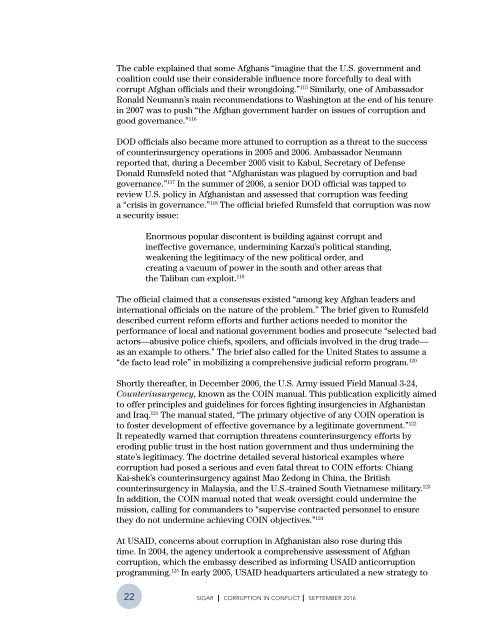CORRUPTION IN CONFLICT
5IlaWjQej
5IlaWjQej
Create successful ePaper yourself
Turn your PDF publications into a flip-book with our unique Google optimized e-Paper software.
The cable explained that some Afghans “imagine that the U.S. government and<br />
coalition could use their considerable influence more forcefully to deal with<br />
corrupt Afghan officials and their wrongdoing.” 115 Similarly, one of Ambassador<br />
Ronald Neumann’s main recommendations to Washington at the end of his tenure<br />
in 2007 was to push “the Afghan government harder on issues of corruption and<br />
good governance.” 116<br />
DOD officials also became more attuned to corruption as a threat to the success<br />
of counterinsurgency operations in 2005 and 2006. Ambassador Neumann<br />
reported that, during a December 2005 visit to Kabul, Secretary of Defense<br />
Donald Rumsfeld noted that “Afghanistan was plagued by corruption and bad<br />
governance.” 117 In the summer of 2006, a senior DOD official was tapped to<br />
review U.S. policy in Afghanistan and assessed that corruption was feeding<br />
a “crisis in governance.” 118 The official briefed Rumsfeld that corruption was now<br />
a security issue:<br />
Enormous popular discontent is building against corrupt and<br />
ineffective governance, undermining Karzai’s political standing,<br />
weakening the legitimacy of the new political order, and<br />
creating a vacuum of power in the south and other areas that<br />
the Taliban can exploit. 119<br />
The official claimed that a consensus existed “among key Afghan leaders and<br />
international officials on the nature of the problem.” The brief given to Rumsfeld<br />
described current reform efforts and further actions needed to monitor the<br />
performance of local and national government bodies and prosecute “selected bad<br />
actors—abusive police chiefs, spoilers, and officials involved in the drug trade—<br />
as an example to others.” The brief also called for the United States to assume a<br />
“de facto lead role” in mobilizing a comprehensive judicial reform program. 120<br />
Shortly thereafter, in December 2006, the U.S. Army issued Field Manual 3-24,<br />
Counterinsurgency, known as the CO<strong>IN</strong> manual. This publication explicitly aimed<br />
to offer principles and guidelines for forces fighting insurgencies in Afghanistan<br />
and Iraq. 121 The manual stated, “The primary objective of any CO<strong>IN</strong> operation is<br />
to foster development of effective governance by a legitimate government.” 122<br />
It repeatedly warned that corruption threatens counterinsurgency efforts by<br />
eroding public trust in the host nation government and thus undermining the<br />
state’s legitimacy. The doctrine detailed several historical examples where<br />
corruption had posed a serious and even fatal threat to CO<strong>IN</strong> efforts: Chiang<br />
Kai-shek’s counterinsurgency against Mao Zedong in China, the British<br />
counterinsurgency in Malaysia, and the U.S.-trained South Vietnamese military. 123<br />
In addition, the CO<strong>IN</strong> manual noted that weak oversight could undermine the<br />
mission, calling for commanders to “supervise contracted personnel to ensure<br />
they do not undermine achieving CO<strong>IN</strong> objectives.” 124<br />
At USAID, concerns about corruption in Afghanistan also rose during this<br />
time. In 2004, the agency undertook a comprehensive assessment of Afghan<br />
corruption, which the embassy described as informing USAID anticorruption<br />
programming. 125 In early 2005, USAID headquarters articulated a new strategy to<br />
22<br />
SIGAR I <strong>CORRUPTION</strong> <strong>IN</strong> <strong>CONFLICT</strong> I SEPTEMBER 2016


